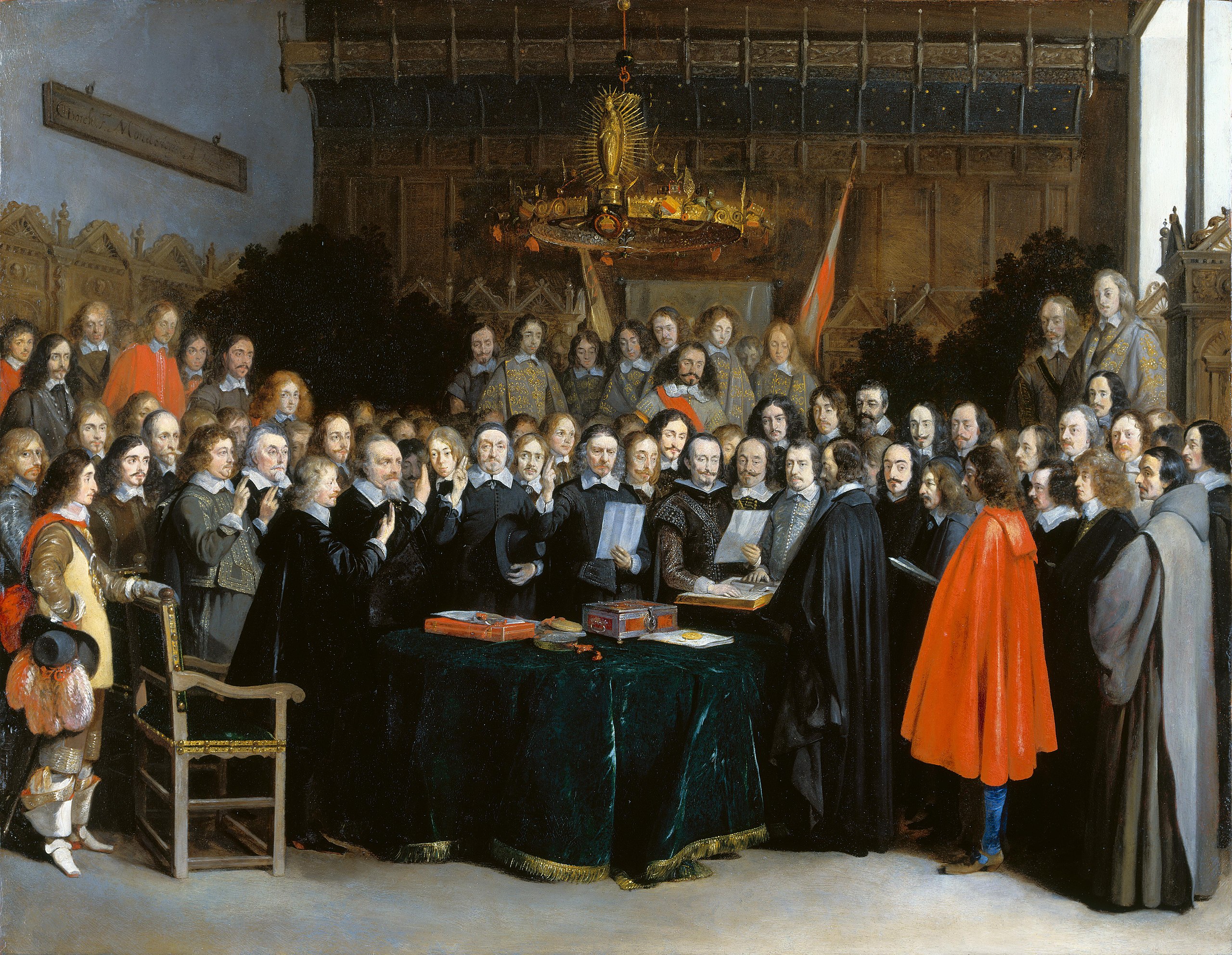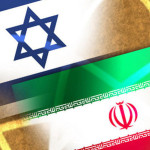by Helena Cobban
It is a time of great uncertainty in international affairs. U.S. troops are deploying to Saudi Arabia for the first time in 16 years, presaging an increasingly probable showdown with Iran. The Anglosphere is likely to soon see a second, intensely nationalistic and straw-maned populist rise to the seat of government. The U.S. president has shredded much of the network of alliances and trade arrangements that circled the globe through decades past. The EU and the UN are both adrift. Some form of reckoning between Washington and Beijing looms ever closer.
It is true that the times look chaotic; and the technological prowess of our era, in terms of cyber, nuclear, and communications capabilities, means that any major conflict could speedily bring catastrophic outcomes. But there is an intriguing precedent from nearly 400 years ago of how a series of nasty, interlocking conflicts can, through dedicated diplomacy, be transformed into arrangements that are a lot more robust, pacific, and stable.
That is the Peace of Westphalia, a set of treaties concluded in 1648 that brought to an end the series of interlocked conflicts in Central Europe known as the Thirty Years War.
Criticism of Westphalia
The Peace of Westphalia has gotten a very bad rap in the past 25 years. One of the key principles underlying it was the near-absolute sovereignty of each individual state. Thus in 1994, when the government in Rwanda orchestrated a brutal orgy of genocidal killing against members of the country’s Tutsi minority, outsiders felt there was little they could do to stop the killing. (The United Nations had had a peacekeeping force in Rwanda for some years by then, but when Pres. Clinton decided he could not commit U.S. air-transport planes to supporting the peacekeepers, UN headquarters had to pull most of them out.)
By contrast, five years later, when Serbian forces were reported as committing mass ethnic cleansing in the country’s province of Kosovo, Clinton and his NATO allies acted fast. They bombed targets inside Serbia as a way to force Belgrade to stop the killing and to support the insurgent Kosovo Liberation Army (KLA) as it fought to wrest control of the province from Belgrade.
In the 1990s, Washington was at the height of its position as “the world’s sole superpower.” When the KLA won control of Kosovo, the role that NATO’s warplanes played in that victory was lauded by many Westerners as a great example of a “humanitarian intervention.” When Clinton and his NATO allies had launched their military effort, they sidestepped the whole idea of even trying to get a UN resolution to authorize it. They just went ahead and did it, insouciantly defying both the UN’s longstanding regulations on the use of force in international affairs and Serbia’s long-recognized sovereignty over Kosovo.
Two years later, the global balance had shifted. In the aftermath of the 9/11 attacks, Pres. George W. Bush was eager to win UN authorization first for the military effort to oust Al-Qaeda and the Taliban from Afghanistan and then for the invasion of Iraq. Regarding Afghanistan, he got it. Regarding Iraq, he claimed that a key, late-2002 UN Security Council resolution gave him authority to use military action, though many other countries’ leaders challenged that claim.
Enter the Responsibility to Protect
Meantime, well-connected figures in some other Western countries had started to investigate the extent to which the United Nations, a global body constituted by a treaty among nearly 200 sovereign states, finds itself unable to respond effectively to atrocities committed (or sanctioned) by national governments against their own citizens—precisely because of that Westphalia-derived principle of state sovereignty which undergirded the UN’s own legitimacy in world affairs. By 2005 these well-meaning souls had persuaded a UN World Summit to adopt the principles of what they called the “Responsibility To Protect” (R2P).
The UN’s adoption of R2P was lauded by many progressives and humanitarians around the world—and also by supporters of military campaigns that are labeled “humanitarian.” R2P was seen as a way of breaking through the barriers to action posed by Westphalian-style sovereignty. The text and principles of R2P did a careful dance with the concept of sovereignty. The first “pillar” of R2P was that each state’s government has a “Responsibility to Protect” the survival and wellbeing of all residents of that state’s land. Pillar II says that all governments have a responsibility to help other governments do that. And then pillar III states that if a government “manifestly fails” to protect the residents of its land in a timely way, then the UN Security Council may authorize a military operation by member states to provide the needed protection.
From the horrors of Rwanda in 1994 through the UN’s adoption of R2P in 2005, the whole concept of Westphalian sovereignty was pilloried—especially on the left. But the track record of R2P since 2005 has not been encouraging, either. The website of the “quasi” non-governmental organization charged with monitoring R2P, the Global Centre for R2P, lists populations in 18 different countries as currently facing some noteworthy level of risk. Some of these situations are chronic and extremely dire (e.g., Palestine, Yemen, Syria, Myanmar). All are in the Global South.
Only in one case—that of the allegedly threatened population of Benghazi, Libya, in March 2011—did the Security Council authorize UN member states to use military force to provide protection. That R2P “intervention” turned out very badly indeed. The states that mounted it far exceeded the UN’s “population protection” mandate, using force to also help topple President Muammar Qadhafi from power. In October 2011, Libyan opposition fighters protected by a NATO air force captured Qadhafi, enacted grotesque tortures on him, and summarily killed him. Since then, Libya has been a Hobbesian nightmare of mutually competing militias, many of which have been credibly accused of major rights violations including enslavement, slave-trafficking, and other forms of human trafficking.
As for Kosovo, site of NATO’s earliest exercise in doing “humanitarian” intervention by force, that small entity remains plagued by deep tensions and mafia activities. On July 19, the prime minister elected in an EU-supervised process there in 2004 and returned to that office by the Kosovan parliament in 2017, Ramush Haradinaj, stepped down to make a return appearance at a special EU-created court investigating serious war crimes committed during the 1999 war.
Westphalia’s Successes and Failures
So, with all the uncertainties plaguing global politics today, it is a good time to go back and re-examine the history of the Peace of Westphalia. Here is my list of what Westphalia, for good or ill, achieved and what it failed to achieve:
1. It ended the Thirty Years War.
That was no small achievement! That period of atrocity-laden warfare, 1618-1648, has been described as one of the most destructive in human history. Eight million people died from the war’s interlocking conflicts that were fueled by princely avarice, intense theological discord between and among Catholics and Protestants, and the ambitions of mercenary commanders.
Twenty-six years into the war, in 1644, the first peace emissaries started gathering in Northern Germany to discuss a possible peace. Eventually, no fewer than 194 of the small states that dotted Europe at that time were represented at the confab. It took them four years to negotiate the twin treaties that together made up the “Peace of Westphalia.” True, Europe has been plagued by numerous large-scale conflicts since 1648. But the basic principles of state sovereignty agreed upon in Westphalia have continued to provide a good, agreed basis for resolving such conflicts among European states.
2. It allowed for a diverse group of states to coexist in Europe.
A large cause of the conflicts of the preceding war had involved theological differences. Those differences were deemed very important by the princes of the time, most of whom sought to impose their own theological understandings on their neighbors—or feared that the neighbors would try to do the same to them. After Westphalia, they all agreed to co-exist, and to respect their neighbors’ boundaries and differences of belief.
3. It allowed some protection for freedom of religion.
At a time when Europe was dotted with small princedoms, when the “Holy Roman Empire” was breaking up and diverging forms of Protestantism were springing up in Europe, the general rule of Westphalia was that the religion of each state’s leader would be the “established” religion of the state. But there was some provision for those citizens who followed other religions to practice them openly, under circumstances that were more or less tightly controlled.
4. It provided a basis for the growth of numerous strong European states over the decades that followed.
For Europeans, this was a huge achievement. The new stability of the Westphalian order allowed for relatively rapid developments in technology, manufacturing, agriculture, and communications and laid the basis for the European domination of much of the world order over the 300 years that followed. (Interestingly, it was the states geographically peripheral to the European landmass that established the most powerful worldwide empires: Spain, Portugal, Britain, France, and Netherlands. Sea access was worth a lot!)
These countries and their empires sometimes still fought each other here or there. But Europe as a whole had recovered sufficiently from the depredations of the Thirty Years War that, between them, those European powers were able fairly soon after 1648 to dominate the global scene.
5. It did not mandate any particular approach to internal governance.
This feature of Westphalia, linked to #2 above, was its “live and let live” principle. Crucially, this feature of the system was what allowed the emergence, development, and consolidation of liberal democracy throughout most of Europe over the centuries after 1648. If there had been no such norm of “live and let live” among the states of Europe, the alternative would have been “might makes right.” Liberal democrats worldwide who decry the protections they see Westphalia as having provided to autocrats around the world often fail to acknowledge this!
6. It provided a good model for the coexistence and cooperation of states espousing different ideologies.
Back in the 17th century CE, those theological differences evidently felt massive—existential!—to many of the rulers and combatants who fought in the Thirty Years War, in a way that may be hard for most Westerners to understand today. But in many places during the war, religious heterodoxy was punished extremely harshly—through burning at the stake, breaking on the wheel, or use of the strappado, as the artist Jacques Callot documented at the time. Westphalia’s “live and let live” approach to religious difference was a great improvement.
Today, leaving aside some parts of the Muslim world, differences of religious belief and practice are not nearly as intense. In today’s world, most of the very intense differences are over political and economic thinking. Nobody has yet been burned at the stake for being a Keynesian or anything like that. But it is interesting to explore how big trading blocks of countries that hew to different philosophical/economic paths might continue to find good ways to coexist—and to cooperate on the even bigger issues that now challenge all of humankind.
7. It didn’t provide any protections at all for rulers or residents of non-European states.
As mentioned in #4 above, Westphalia provided a robust basis for the growth of European states and, over the 250 years that followed, for the emergence of European dominion over nearly all the rest of the world. This was terrible news for most non-Europeans, who were not recognized by the European powers as deserving of any of the protections that Westphalian sovereignty accorded to Europeans.
Westphalia allowed and laid the basis for the development of European imperialisms that involved horrors like the trans-Atlantic slave trade, settler colonialism in many continents, and numerous genocides of non-European people.
Westphalia during the Cold War
With the creation of the United Nations in 1945, the principles of Westphalian sovereignty were extended—in many cases, still only putatively—to all the states in the world. This was a good, if still only partial, step towards building a more equitable international order. Other good steps included the endorsement by most of the world’s states of the 1948 Universal Declaration of Human Rights and of the two covenants attached to it in 1976: one on Civil and Political Rights and the other on Economic, Social, and Cultural Rights. (The United States has not ratified the second of these.)
In 1975, at the height of the US-Soviet Cold War, the United States, the Soviet Union, and 33 other states from east and west Europe (and Canada) reached agreement on the Helsinki Accord, a far-reaching agreement to temper many of the political and military aspects of the east-west confrontation. In the Helsinki Accord, all signatories agreed to respect the civil and political rights of their citizens—a provision that paved the way for the civilian mass movements in Eastern Europe that in the late 1980s toppled the Berlin Wall and were an essential component (along with the smart diplomacy of American and Russian leaders) of the peaceful ending of the Cold War.
Helsinki also mandated the creation of a pan-European body, the Organization for Security and Cooperation in Europe (OSCE), tasked with monitoring and defusing any threats to the security of member states. The OSCE also played an essential role in allowing the peaceful unwinding of the Cold War.
All those diplomatic successes were achieved within the broader framework of a respect for Westphalian-style sovereignty.
(Significantly, during the crucial weeks of 1999 in which the Kosovo crisis became more intense, the OSCE had had multinational monitoring teams on the ground, investigating rights abuse claims in the province; and they had reported some success in reversing a portion of the ethnic cleansing earlier committed there. But once NATO decided to bomb its way to victory instead, it ordered the evacuation of those OSCE teams.)
Today, a global political system that for 350 years has been dominated by nations of the “West” finds itself approaching a crossroads. The principles on which this system has been based until now are in question—many of them, quite rightly so. But the essential Westphalian principles of “live and let live,” of non-interference in the internal affairs of other states, and of the need for co-existence and co-operation among states run along deeply divergent lines have a value that is perhaps greater now than at any time since the unsettled years of 1640s. These are principles that are worth reviving, embracing, and where necessary further developing.






HELENA COBBAN
What about the role of France in the “Horrors of Rwanda”?
Why has no Frenchman indicted, tried, and executed for those crimes?
Or how about the lies of the European Union about “3000” Kosovars murdered by the Serbs?
The answer to Western imposed instability is to target their capitals.
Must read article for all heads of states n their diplomats. It succinctly sums up the horrors faced by the world due growing dissentions in theology, geopolitics, trade n economy and is a stark reminder to overcome such triggers before the explosion.